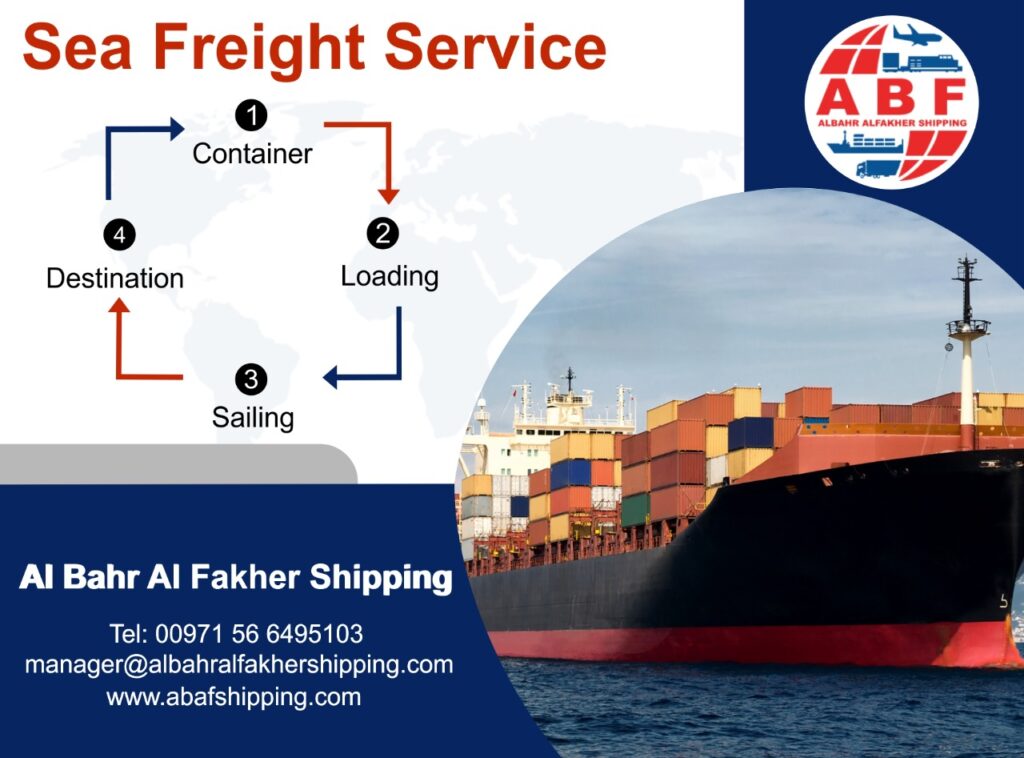A significant portion of the overall global transportation industry is made up of sea freight shipping. At least 20 million containers are crossing the world at any given time.

What is Sea Freight Shipping and How Does It Work?
The term ‘Sea Freight’ often refers to huge cargo. Moving cargo by sea from a port of origin to a port of destination is known as sea freight shipping. The process can be divided into numerous parts and can occur in various ways. Every cargo involves three stages: the beginning at the origin, the middle during transit, and the end at the final destination. Trucking, export customs clearance, and coordination with shipping lines may be included in this.
There are undoubtedly other ways to transport products. However, did you know? The most used type of freight transportation is sea freight and then come the rail, road, and air freight. The majority of the heavy lifting of cargo is done through containerization and shipment via oceans, with the ocean taking the lead.
So let’s find out what is sea freight and how it works!
What Is Sea Freight Shipping?
Sea freight is all about shipping containers and how they enable you to send your goods through the sea. Shipping large goods is frequently referred to as “sea freight.” It assists in carrying heavy containers with appropriate safety precautions in place by making the transit smooth.
A significant portion of the overall global transportation industry is made up of sea freight shipping. At least 20 million containers are crossing the world at any given time. Many shippers are of the opinion that shipping by water is comparatively inexpensive, especially when shipping in large quantities. In many instances, this might be true.
Working Process of Sea Freight
From the shipper’s location to the point of delivery at the consignee’s premises, sea freight shipments pass across a few important aspects. It may help to fully comprehend these procedures to ensure that your shipments are processed without issue. Undoubtedly, the type of service will play a significant role in determining what these milestones are. Bulk or break-bulk cargo is handled one way, whereas containerized goods is handled another. The key phases of containerized cargo are listed below:
- Acquiring a container: This is more like booking your seat for a flight. You merely need to ensure that your cargo has space on the ship. The same goes for air cargo as well.
- Before Carriage: In this instance, a vehicle with an empty container is dispatched to the container terminal to pick up the unfilled container, transport it to the supplier’s facility for loading, and then return it back once it has been filled and sealed to the container yard once more for shipping.
- Loading the ship: The container is manifested on board the vessel and moved closer to the pier for the ship once it has been placed back into the container terminal. Naturally, export customs clearance is being handled in the meanwhile. The manifested containers will be lifted by a crane and loaded into the ship.
- Sailing through the ship: The ship will likely travel directly from its point of origin to its point of destination if this is direct sailing. Another option is that it will be indirect, in which case there would be few transit stops where container boxes can exchanged.
- Discharge from the container: In certain countries, import customs clearance is completed prior to arrival, while in others, beneficiaries must wait for the container to arrive. The cargo and container are manifested at the destination port. When the ship docks, cranes unload the containers and transport them to the designated container yards.
- On-Carriage: In order to unload the cargo from the container and return the empty box to the container yard, the container is picked up from the destination container yard and transported to the facilities of the consignee or recipient.
Some of the Services Offered By Sea Freight
Let’s have a look at some of the sea freight services here:
- Use of Containers for Cargo:
It is also called containerized cargo. This shipping strategy is based on globally standardized boxes. To transport coal to Manchester, a box boat called the “starvationer” made of ten wooden boxes was constructed in the late 18th century. There should be one of these two methods used by carriers when sending cargo in containers:
Full Container Load (FCL):
When the shipper decides to reserve a whole container just for them in order to ship their goods. There are many different kinds of containers. The most typical examples are:
Standard Container: These are the ones that are utilized the most frequently. It has four primary categories (20 ft, 40 ft, 45 ft containers). For general cargo, standard box containers are utilized. The recommended choice for volumetric freight (lightweight, high-volume cargo) is a 45-foot container.
Reefer Container: Temperature management is necessary for some commodities in order to maintain the integrity of the cargo. The 20 RF and 40 RF sizes make up the majority of reefer containers. Similar to the standard box container sizes, but equipped with generator sets that can cool a box to a temperature of –65 °C (- 85 F).
High Cube Container: It is basically a 40 HC container. A preferable alternative for volumetric cargo that is similar to but has a shorter internal length than a 45-foot container. The height of a 40 HC container is roughly 56 cm (22 inches) taller than a standard 40-foot container.
Less Than a Container Load (LCL): The shippers won’t always have enough volume to reserve a whole container. Sometimes, the shipment consists only of 2-3 pallets and it is not a good option to pay the price of a full container load. Here, LCL comes in handy. In LCL, the shipping charges are calculated per ton and it is relatively less expensive than FCL. Every LCL cargo, however, has a break-even point. If LCL’s total cost feels high, it is better to ask for the FCL cost. There won’t be much of a difference in both the costs, but FCL has the edge of transporting the goods quicker than LCL.
Open Top Containers: All types of containers have a specific height. Even there’s a limit for dimensions of the loaded cargo in HC containers. It has a height limit of around 2.5 meters for loaded cargo. But sometimes, we need a higher capacity. This is where open-top containers are the best. Open Top Containers offer height capacities of 20ft and 40ft while being open from the top. If we compare the prices, they are more expensive than standard containers, and less space is reserved for them on every ship.
- Break-Bulk Cargo:
Contrary to containerized freight, break-bulk cargo is transported aboard different vessels. Break-Bulk shipments are made up of countable pieces that are placed on the ship as individual items or bundles. Breakbulk charges are computed per TON or per CBM (whichever is higher). Break-bulk cargoes include barrels, packed goods, structural steel, etc.
- Bulk Cargo:
Bulk cargo differs from break-bulk because the shipment is not made up of separate pieces that can be counted. Typically, bulk cargo ships have hatches for loading the shipment. Grain, coal, oil, and other goods are examples of bulk shipments. Some of these hatches’ unloading is accomplished using vacuums at the discharge port.
- Oil Tankers:
Also referred to as petroleum tankers. These are boats created specifically to transport large quantities of petroleum products. There are two different kinds of oil tankers; crude tankers, which move large amounts of crude oil from the point of extraction to the location where it will be processed, and product tankers, which are smaller than crude tankers and are used to transport processed goods from refineries to their destinations, like gasoline. Oil tankers are classified depending on their load capacity, the tankers that carry only a few thousand tons of dead weight. The Seawise Giant is the largest tanker with a loading capacity of up to 550 thousand tons.
- Roll On & Roll Off Services (RoRo):
We infer from the term that this refers to all items having wheels. The CBM determines the costs and uses special vessels to transport this cargo. Of course, this type of cargo is carried by less specialized carriers than by container carriers.
Final Saying: What Is Sea Freight Shipping?
Sea freight is the process of shipping goods by sea. It is a popular method of transport for large and heavy items, as it is generally more cost-effective than air freight. Goods are typically transported in containers, which are loaded onto cargo ships. The journey time depends on the distance to be traveled and the weather conditions, but it can take anywhere from a few days to a few weeks.
